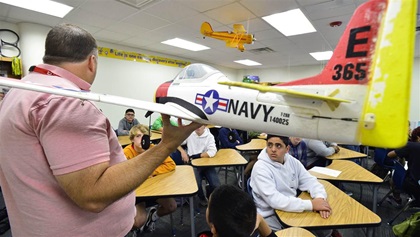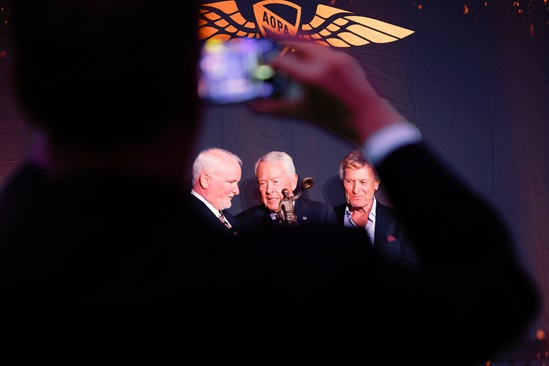AOPA Annual Report: Reaching for the sky
AOPA is building GA's future
By AOPA Staff
Photography by Mike Fizer, Chris Rose, and David Tulis
What does the future of general aviation hold? If only we knew...

 What we can do is work for the future of general aviation we want, and that is what AOPA has been doing since its inception in 1939.
What we can do is work for the future of general aviation we want, and that is what AOPA has been doing since its inception in 1939.
When the association’s five founders met at a Philadelphia airport to draw up its charter and file its incorporation papers, did they have any idea what GA would look like at the dawn of the twenty-first century? Could they envision that many pilots would fly single-engine piston aircraft boasting avionics that rival those found in commercial jets, while others would cherish antique and vintage airplanes that represent aviation’s golden era, and still others work tirelessly to keep warbirds aloft to commemorate America’s airborne supremacy?
This is the state of general aviation as we know it: a fascinating mix of old and new technology, brand-new and highly experienced pilots, and a unifying love of flying. Now as then, AOPA works for all pilots—from the newcomers who are taking their first flight, and the weekend fliers who call a general aviation airport their home away from home, to the pilots who fly for a living and use general aviation as their main means of transportation—to keep our skies safe, affordable, and attainable.
We create new pilots
 The size of the pilot population continues to be AOPA’s main challenge. AOPA is no stranger to this battle; the number of active pilots is down more than 20 percent from a high in 1980. There’s reason for optimism, however. The numbers of student starts and active pilots have climbed in recent years, and AOPA is doing its part to power this trend reversal. You Can Fly—a multifaceted program designed to get people flying and keep them flying—is working. We have the numbers to back up our claims.
The size of the pilot population continues to be AOPA’s main challenge. AOPA is no stranger to this battle; the number of active pilots is down more than 20 percent from a high in 1980. There’s reason for optimism, however. The numbers of student starts and active pilots have climbed in recent years, and AOPA is doing its part to power this trend reversal. You Can Fly—a multifaceted program designed to get people flying and keep them flying—is working. We have the numbers to back up our claims.
One of the unique aspects of You Can Fly is its STEM education component. As part of its High School Initiative, AOPA is offering a rigorous four-year science, technology, engineering, and math curriculum with tracks focused on piloting and unmanned aircraft. Schools can implement one or more full four-year pathways, or they can select individual courses to use as standalone electives. Ninth, tenth, and eleventh grade courses are now being used, and the twelfth-grade curriculum will be ready for field testing in fall 2020.
We provide these courses at no charge to high schools around the United States. In the current school year, more than 5,000 students at 161 schools in 34 states are using the curriculum. These schools are large and small; public and private; rural, urban, and suburban. By bringing the aviation STEM curriculum to the classroom, we’re reaching more young people than ever. And we’re making strides in other demographics: Twenty-two percent of the students who utilize the aviation STEM curriculum are female, and 38 percent come from under-represented groups.
Not only are we drawing more young people into aviation, we’re helping to prepare them for highly rewarding aviation careers. There’s an ever-widening pilot and mechanic void, and AOPA will continue to inspire young people to fill those jobs.
AOPA Consolidated
Amounts in thousands (unaudited)

The bulk of AOPA’s revenue in 2019 came from membership dues and grants. Mission constitutes the bulk of expenses and includes advocacy, media, member-focused programs such as You Can Fly, fly-ins, and the Air Safety Institute. Not shown here are non-operating investment gains.
The AOPA Foundation, Inc.
Amounts in thousands (unaudited)

Education constitutes the bulk of expenses in the form of grants to support AOPA fly-ins; the Air Safety Institute; and You Can Fly programs focused on developing flying clubs, supporting AOPA Ambassadors, flight training, the Rusty Pilots initiative, and the high school program.
We’re not just patting ourselves on the back when it comes to the High School Initiative. In 2019 American Airlines invited schools that utilize the AOPA STEM curriculum to apply for education grants worth up to $20,000. The curriculum “is really making a difference in the lives of the students in the program, and American Airlines recognizes that,” said Brad Morrison, manager of pilot career recruiting at American.
We help student pilots
You Can Fly’s mission is to get pilots flying and keep them flying. We know aviation can be a confusing world to enter, particularly if you don’t know anyone else who’s a pilot. That’s why AOPA created a special issue of Flight Training magazine called “You Can Fly: Your Path to Become a Pilot.” We packed this special issue for new pilots with essential articles on medical certificate questions and resources, flying gear, training airplanes, technology, the alphabet soup of aviation abbreviations and acronyms, financing, and what to do with your pilot certificate. We sent free magazines and countertop displays to more than 850 flight schools all around the United States, and prospective pilots can access a free digital copy at ft.aopa.org/youcanfly. Flight school owners and managers tell us the magazine is a great tool for their customers.
AOPA continues to work with flight schools to help them provide the highest quality training possible so that student pilots will stay engaged and focused on obtaining their certificates. You Can Fly is developing a new adaptive training system for student pilots that will automatically create personalized lessons and assign homework based on student progress. The adaptive training system is now in beta testing. We continue to recognize overall excellence in training with the Flight Training Experience Awards, which highlight the best of the best in the industry based on feedback from more than 6,300 responses to our annual Flight Training Experience Survey. Flight Training Experience Award winners say this recognition from AOPA brings customers to their doors.
We’re growing a network of flying clubs around the United States, offering pilots an affordable way to learn to fly and experience aircraft ownership while connecting with fellow pilots. You Can Fly’s Flying Clubs Initiative has helped 145 new clubs get off the ground since its inception in 2015.
You Can Fly is funded through the support of the AOPA Foundation, a 501(c)(3) organization.
We work to keep pilots safer
The general aviation fatal accident rate continues at an all-time low. To keep it low, the AOPA Air Safety Institute influences and guides the development of a stronger and robust general aviation safety culture—a responsibility it does not take lightly. ASI delivers engaging, relevant training and safety materials to pilots in whatever format they seek, whether via videos, podcasts, newsletters, social media, or live presentations. In 2019, views of ASI videos and participation in ASI’s online and in-person education exceeded 7.7 million. ASI’s Joseph T. Nall Report, an analysis of general aviation accidents used by government and industry to drive new and modified safety initiatives, was delivered in digital format in 2019 and optimized for viewing on mobile devices.
A safety program launched in 2019, Scalable Safety Framework, helps public benefit groups, flying clubs, and others formulate, implement, and sustain a safety culture that is geared and scaled to a specific organization. The program’s downloadable PowerPoint presentation and supporting PDF can be tailored to address specific audiences.
ASI continues to be a leader in the delivery of flight instructor refresher courses (FIRCs). ASI’s online and in-person FIRCs renew more flight instructors each year than any other instructor renewal program in the industry. In 2019, ASI renewed more than 8,000 flight instructor certificates.
We fight for pilots
AOPA is engaged with hundreds of state agencies and legislatures to protect the interests of GA pilots. More than 1,600 Airport Support Network volunteers across the nation form a grassroots network of GA advocates to support local airports with FAA rules, regulations, and funding. We’re here for the local pilot community, engaging with airport managers and local decision makers, all in an effort to protect our nation’s airport ecosystem, which is vital to a strong and vibrant general aviation network.
In the past year we have been working with the industry, regulators, and community leaders to ensure that public airports provide transparent pricing and access to all aircraft. Transparency enables pilots to be fully aware of the prices they will pay for ramp, tiedown, security, facility, infrastructure, and access fees—so that they can make informed decisions about which airports and businesses best suit their needs. We publish fees in the AOPA Airport Directory (aopa.org/destinations) so that you will know what to expect when you land at an airport.
In state legislatures throughout the country, we advocate for our members to prevent excess state taxation on flying, maintain sufficient funding for GA airports and infrastructure, and protect general aviation from unnecessary regulation. In 2019, we successfully blocked legislation that would have restricted flying club and skydiving operations at private airports in Michigan and led efforts to increase funding for Montana airports, increase ramp and hangar capacity at Indiana airports, and dedicate funding to North Dakota airports, among other successes (see “2019 Advocacy Accomplishments,” p. 64).
On Capitol Hill, AOPA has worked to build congressional relationships through the GA caucuses. The Washington, D.C.-based advocacy team also has been involved in efforts related to drones and urban air mobility that assure safe access for all. After defeating an airline attempt to take over our ATC system in recent years, the team remains vigilant against user fees and other proposals that could limit pilots’ access to the skies. And we’ve collaborated with U.S. Customs and Border Protection to expedite the border crossing experience. International travelers also can benefit from Mexico’s acceptance of pilots flying under BasicMed—and now, the number of pilots flying under this alternative to third class medical certification has grown to nearly 56,000. Washington, D.C.-based publication The Hill recognized the association for this wide-ranging advocacy work by naming us one of the nation’s top advocacy organizations for the sixth year in a row.
In early 2020, a bipartisan bill introduced in the Senate gave AOPA further reason to be hopeful about the future of general aviation. AOPA and a wide swath of the aviation community support the effort to create the National Center for the Advancement of Aviation, a national, independent forum to facilitate collaboration between all sectors of aviation and aerospace to coordinate, promote, and support the future of aviation.
We love meeting pilots
 When AOPA switched our format from a single annual get-together for members to a series of regional fly-ins in 2014, we knew we’d hit upon a winning strategy. We have hosted 27 events in 20 states, and we have connected with more than 130,000 attendees. Pilots tell us they love meeting their association where they live and fly. Attendance has grown 425 percent from 2014 to 2019.
When AOPA switched our format from a single annual get-together for members to a series of regional fly-ins in 2014, we knew we’d hit upon a winning strategy. We have hosted 27 events in 20 states, and we have connected with more than 130,000 attendees. Pilots tell us they love meeting their association where they live and fly. Attendance has grown 425 percent from 2014 to 2019.
Our two-day format is a big hit with members, too. They can attend free seminars and paid workshops, enjoy a Pilot Town Hall with AOPA President Mark Baker, or experience a new flying destination by participating in an organized fly-out.
GA will always have a voice
No future is guaranteed—but these initiatives and more are helping to secure the future we envision.
“General aviation continues to evolve and grow in many different ways, and we must do the same,” said AOPA President and CEO Mark Baker. “AOPA will always be here to support pilots no matter their experience level and background. We look forward to welcoming many new pilots into the industry while we work hard to fill the pipeline, advance safety, and improve affordability and access for all.”


